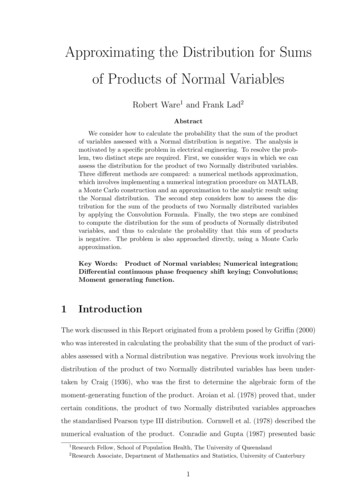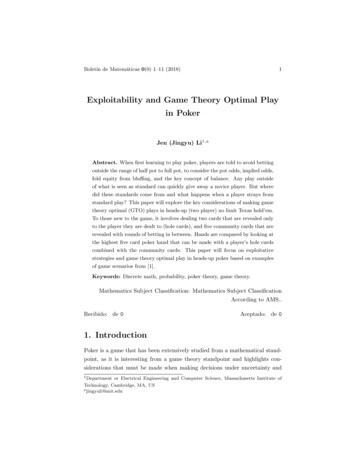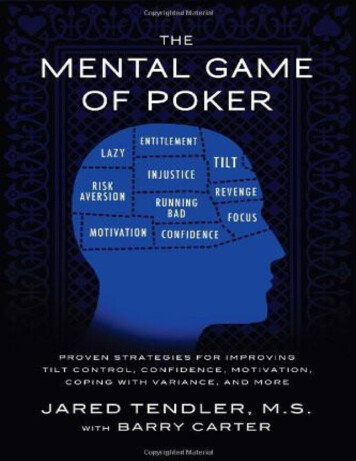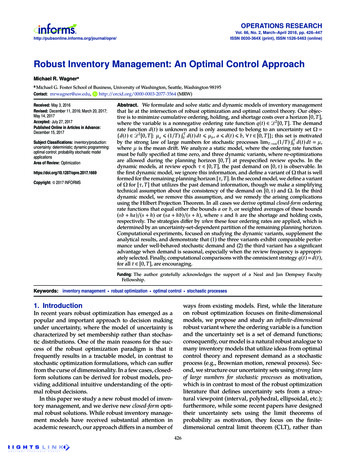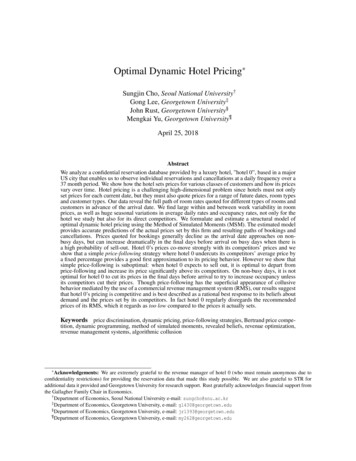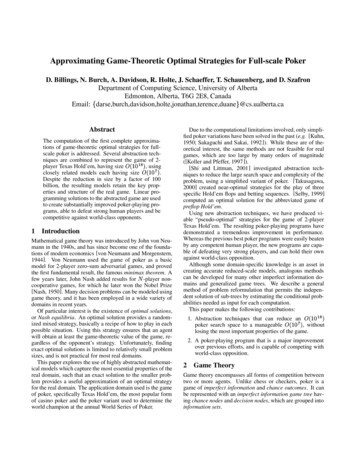
Transcription
Approximating Game-Theoretic Optimal Strategies for Full-scale PokerD. Billings, N. Burch, A. Davidson, R. Holte, J. Schaeffer, T. Schauenberg, and D. SzafronDepartment of Computing Science, University of AlbertaEdmonton, Alberta, T6G 2E8, CanadaEmail: darse,burch,davidson,holte,jonathan,terence,duane @cs.ualberta.caAbstractThe computation of the first complete approximations of game-theoretic optimal strategies for fullscale poker is addressed. Several abstraction techniques are combined to represent the game of 2, usingplayer Texas Hold’em, having size.closely related models each having sizeDespite the reduction in size by a factor of 100billion, the resulting models retain the key properties and structure of the real game. Linear programming solutions to the abstracted game are usedto create substantially improved poker-playing programs, able to defeat strong human players and becompetitive against world-class opponents. 1 IntroductionMathematical game theory was introduced by John von Neumann in the 1940s, and has since become one of the foundations of modern economics [von Neumann and Morgenstern,1944]. Von Neumann used the game of poker as a basicmodel for 2-player zero-sum adversarial games, and provedthe first fundamental result, the famous minimax theorem. Afew years later, John Nash added results for -player noncooperative games, for which he later won the Nobel Prize[Nash, 1950 ]. Many decision problems can be modeled usinggame theory, and it has been employed in a wide variety ofdomains in recent years.Of particular interest is the existence of optimal solutions,or Nash equilibria. An optimal solution provides a randomized mixed strategy, basically a recipe of how to play in eachpossible situation. Using this strategy ensures that an agentwill obtain at least the game-theoretic value of the game, regardless of the opponent’s strategy. Unfortunately, findingexact optimal solutions is limited to relatively small problemsizes, and is not practical for most real domains.This paper explores the use of highly abstracted mathematical models which capture the most essential properties of thereal domain, such that an exact solution to the smaller problem provides a useful approximation of an optimal strategyfor the real domain. The application domain used is the gameof poker, specifically Texas Hold’em, the most popular formof casino poker and the poker variant used to determine theworld champion at the annual World Series of Poker. Due to the computational limitations involved, only simplified poker variations have been solved in the past (e.g. [Kuhn,1950; Sakaguchi and Sakai, 1992 ]). While these are of theoretical interest, the same methods are not feasible for realgames, which are too large by many orders of magnitude([Koller and Pfeffer, 1997 ]).[Shi and Littman, 2001 ] investigated abstraction techniques to reduce the large search space and complexity of theproblem, using a simplified variant of poker. [Takusagawa,2000] created near-optimal strategies for the play of threespecific Hold’em flops and betting sequences. [Selby, 1999]computed an optimal solution for the abbreviated game ofpreflop Hold’em.Using new abstraction techniques, we have produced viable “pseudo-optimal” strategies for the game of 2-playerTexas Hold’em. The resulting poker-playing programs havedemonstrated a tremendous improvement in performance.Whereas the previous best poker programs were easily beatenby any competent human player, the new programs are capable of defeating very strong players, and can hold their ownagainst world-class opposition.Although some domain-specific knowledge is an asset increating accurate reduced-scale models, analogous methodscan be developed for many other imperfect information domains and generalized game trees. We describe a generalmethod of problem reformulation that permits the independent solution of sub-trees by estimating the conditional probabilities needed as input for each computation.This paper makes the following contributions: 1. Abstraction techniques that can reduce anpoker search space to a manageable, withoutlosing the most important properties of the game. 2. A poker-playing program that is a major improvementover previous efforts, and is capable of competing withworld-class opposition.2 Game TheoryGame theory encompasses all forms of competition betweentwo or more agents. Unlike chess or checkers, poker is agame of imperfect information and chance outcomes. It canbe represented with an imperfect information game tree having chance nodes and decision nodes, which are grouped intoinformation sets.
Since the nodes in this tree are not independent, divideand-conquer methods for computing sub-trees (such as thealpha-beta algorithm) are not applicable. For a more detaileddescription of imperfect information game tree structure, see[Koller and Megiddo, 1992 ].A strategy is a set of rules for choosing an action at every decision node of the tree. In general, this will be a randomized mixed strategy, which is a probability distributionover the various alternatives. A player must use the same policy across all nodes in the same information set, since fromthat player’s perspective they are indistinguishable from eachother (differing only in the hidden information component).The conventional method for solving such a problem is toconvert the descriptive representation, or extensive form, intoa system of linear equations, which is then solved by a linear programming (LP) system such as the Simplex algorithm.The optimal solutions are computed simultaneously for allplayers, ensuring the best worst-case outcome for each player.Traditionally, the conversion to normal form was accompanied by an exponential blow-up in the size of the problem, meaning that only very small problem instances couldbe solved in practice. [Koller et al., 1994] described an alternate LP representation, called sequence form, which exploitsthe common property of perfect recall (wherein all playersknow the preceding history of the game), to obtain a systemof equations and unknowns that is only linear in the size ofthe game tree. This exponential reduction in representationhas re-opened the possibility of using game-theoretic analysis for many domains. However, since the game tree itselfcan be very large, the LP solution method is still limited tomoderate problem sizes (normally less than a billion nodes).3 Texas Hold’emA game (or hand) of Texas Hold’em consists of four stages,each followed by a round of betting:Preflop: Each player is dealt two private cards face down(the hole cards).Flop: Three community cards (shared by all players) aredealt face up.Turn: A single community card is dealt face up.River: A final community card is dealt face up.After the betting, all active players reveal their hole cardsfor the showdown. The player with the best five-card pokerhand formed from their two private cards and the five publiccards wins all the money wagered (ties are possible).The game starts off with two forced bets (the blinds) putinto the pot. When it is a player’s turn to act, they must either bet/raise (increase their investment in the pot), check/call(match what the opponent has bet or raised), or fold (quit andsurrender all money contributed to the pot).The best-known non-commercial Texas Hold’em programis Poki. It has been playing online since 1997 and has earnedan impressive winning record, albeit against generally weakopposition [Billings et al., 2002 ]. The system’s abilitiesare based on enumeration and simulation techniques, expertknowledge, and opponent modeling. The program’s weaknesses are easily exploited by strong players, especially inthe 2-player game.Figure 1: Branching factors for Hold’em and abstractions.4 AbstractionsTexas Hold’em has an easily identifiable structure, alternating between chance nodes and betting rounds in four distinctstages. A high-level view of the imperfect information gametree is shown in Figure 1.Hold’em can be reformulated to produce similar but muchsmaller games. The objective is to reduce the scale of theproblem without severely altering the fundamental structureof the game, or the resulting optimal strategies. There aremany ways of doing this, varying in the overall reduction andin the accuracy of the resulting approximation.Some of the most accurate abstractions include suit equivalence isomorphisms (offering a reduction of at most a factorof ), rank equivalence (only under certain conditions),and rank near-equivalence. The optimal solutions to these abstracted problems will either be exactly the same or will havea small bounded error, which we refer to as near-optimal solutions. Unfortunately, the abstractions which produce an exact or near-exact reformulation do not produce the very largereductions required to make full-scale poker tractable.A common method for controlling the game size is deckreduction. Using less than the standard 52-card deck greatlyreduces the branching factor at chance nodes. Other methodsinclude reducing the number of cards in a player’s hand (e.g.from a 2-card hand to a 1-card hand), and reducing the number of board cards (e.g. a 1-card flop), as was done by [Shiand Littman, 2001] for the game of Rhode Island Hold’em.[Koller and Pfeffer, 1997 ] used such parameters to generate awide variety of tractable games to solve with their Gala system.We have used a number of small and intermediate sizedgames, ranging from eight cards (two suits, four ranks) to 24cards (three suits, eight ranks) for the purpose of studyingabstraction methods, comparing the results with known exactor near-optimal solutions. However, these smaller games arenot suitable for use as an approximation for Texas Hold’em,as the underlying structures of the games are different. Toproduce good playing strategies for full-scale poker, we lookfor abstractions of the real game which do not alter that basic
structure.The abstraction techniques used in practice are powerfulin terms of reducing the problem size, and subsume thosepreviously mentioned. However, since they are also muchcruder, we call their solutions pseudo-optimal, to emphasizethat there is no guarantee that the resulting approximationswill be accurate, or even reasonable. Some will be low-riskpropositions, while others will require empirical testing to determine if they have merit.4.1Betting round reductionThe standard rules of limit Hold’em allow for a maximum offour bets per player per round. 1 Thus in 2-player limit pokerthere are 19 possible betting sequences, of which two do notoccur in practice.2 Of the remaining 17 sequences, 8 end in afold (leading to a terminal node in the game tree), and 9 endin a call (carrying forward to the next chance node). Using , , , , ,and capital letters for the second player, the tree of possiblebetting sequences for each round is: kK kBf kBc kBrF kBrC kBrRf kBrRc kBrRrF kBrRrCbF bC bRf bRc bRrF bRrC bRrRf bRrRcWe call this local collection of decision nodes a bettingtree, and represent it diagramatically with a triangle.With betting round reduction, each player is allowed amaximum of three bets per round, thereby eliminating the lasttwo sequences in each line. The effective branching factor ofthe betting tree is reduced from nine to seven. This does notappear to have a substantial effect on play, or on the expectedvalue (EV) for each player. This observation has been verifiedexperimentally. In contrast, we computed the correspondingpostflop models with a maximum of two bets per player perround, and found radical changes to the optimal strategies,strongly suggesting that that level of abstraction is not safe.4.2Elimination of betting roundsLarge reductions in the size of a poker game tree can be obtained by elimination of betting rounds. There are severalways to do this, and they generally have a significant impacton the nature of the game. First, the game may be truncated,by eliminating the last round or rounds. In Hold’em, ignoring the last board card and the final betting round produces a3-round model of the actual 4-round game. The solution tothe 3-round model loses some of the subtlety involved in thetrue optimal strategy, but the degradation applies primarily toadvanced tactics on the turn. There is a smaller effect on theflop strategy, and the strategy for the first betting round mayhave no significant changes, since it incorporates all the outcomes of two future betting rounds. We use this particularabstraction to define an appropriate strategy for play in thefirst round, and thus call it a preflop model (see Figure 2).1Some rules allow unlimited raises when only two players areinvolved. However, occasions with more than three legitimate raisesare relatively rare, and do not greatly alter an optimal strategy.2Technically, a player may fold even though there is no outstanding bet. This is logically dominated by not folding, and thereforedoes not occur in an optimal strategy, and is almost never seen inpractice.The effect of truncation can be lessened through the useof expected value leaf nodes. Instead of ending the gameabruptly and awarding the pot to the strongest hand at thatmoment, we compute an average conclusion over all possiblechance outcomes. For a 3-round model ending on the turn,we roll-out all 44 possible river cards, assuming no furtherbetting (or alternately, assuming one bet per player for thelast round). Each player is awarded a fraction of the pot, corresponding to their probability of winning the hand. In a 2round preflop model, we roll-out all 990 2-card combinationsof the turn and river.The most extreme form of truncation results in a 1-roundmodel, with no foresight of future betting rounds. Since eachfuture round provides a refinement to the approximation, thiswill not reflect a correct strategy for the real game. In particular, betting plans that extend over more than one round,such as deferr
Approximating Game-Theoretic Optimal Strategies for Full-scale Poker D. Billings, N. Burch, A. Davidson, R. Holte, J. Schaeffer, T. Schauenberg, and D. Szafron Department of Computing Science, University of Alberta Edmonton, Alberta, T6G 2E8, Canada Email: darse,burch,davidson,holte,jonathan,terence,duane @cs.ualberta.ca Abstract The computation of the

